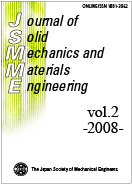Volume 2, Issue 5
Displaying 1-10 of 10 articles from this issue
- |<
- <
- 1
- >
- >|
Papers
-
2008 Volume 2 Issue 5 Pages 582-592
Published: 2008
Released on J-STAGE: May 30, 2008
Download PDF (1053K) -
2008 Volume 2 Issue 5 Pages 593-603
Published: 2008
Released on J-STAGE: May 30, 2008
Download PDF (912K) -
2008 Volume 2 Issue 5 Pages 604-615
Published: 2008
Released on J-STAGE: May 30, 2008
Download PDF (685K) -
2008 Volume 2 Issue 5 Pages 616-635
Published: 2008
Released on J-STAGE: May 30, 2008
Download PDF (4177K) -
2008 Volume 2 Issue 5 Pages 636-644
Published: 2008
Released on J-STAGE: May 30, 2008
Download PDF (666K) -
2008 Volume 2 Issue 5 Pages 645-653
Published: 2008
Released on J-STAGE: May 30, 2008
Download PDF (3689K) -
2008 Volume 2 Issue 5 Pages 654-665
Published: 2008
Released on J-STAGE: May 30, 2008
Download PDF (494K) -
2008 Volume 2 Issue 5 Pages 666-674
Published: 2008
Released on J-STAGE: May 30, 2008
Download PDF (2667K) -
2008 Volume 2 Issue 5 Pages 675-684
Published: 2008
Released on J-STAGE: May 30, 2008
Download PDF (415K) -
2008 Volume 2 Issue 5 Pages 685-694
Published: 2008
Released on J-STAGE: May 30, 2008
Download PDF (350K)
- |<
- <
- 1
- >
- >|
